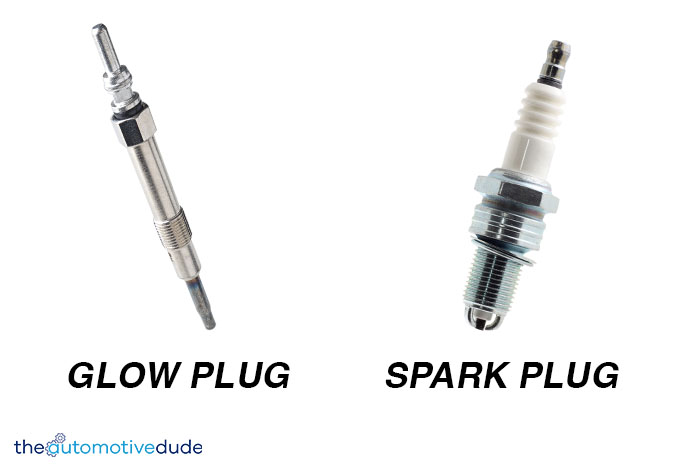Diesel engines are becoming more prevalent in today’s vehicles. Traditionally, diesel engines were only found in large trucks, but now they appear in smaller trucks and some passenger cars. Many people are familiar with gasoline engines and how the combustion process works. Spark plugs are a crucial piece of this process; however, diesel engines function a little differently. Diesel fuel is much different than gasoline, and these differences play a big role in how diesel engines operate. If you are wondering about spark plugs in your diesel engine, keep reading. We will tell you how many spark plugs your diesel engine has, and the answer might surprise you!
Table of Contents
How Many Spark Plugs Does A Diesel Have?
If you wonder, “Do diesels have spark plugs,” the answer is no. There are zero spark plugs on a diesel engine. Many people find this answer surprising, although it is not as shocking once you understand how a diesel engine works. Instead of spark plugs, a diesel engine utilizes glow plugs. Glow plugs perform a similar function to spark plugs, although the way they behave is a little different.
We will go into more detail on the differences between spark plugs and glow plugs in the next section. In addition, we’ll cover the different types of glow plugs and tell you how many glow plugs are in a diesel later in this article.
Spark Plugs vs. Glow Plugs — What’s The Difference?

To understand the difference between spark plugs and glow plugs, it helps to have an understanding of the combustion process in both gasoline and diesel motors. Let’s start with the process for gasoline engines. In a gas engine, fuel enters the combustion chamber. In modern vehicles, the fuel is sprayed into the chamber by the fuel injectors. As the piston reaches the top of its compression stroke, the ignition system fires and creates a small spark on the tip of the spark plug. Since the end of the spark plug is also located in the combustion chamber, this spark causes the fuel to ignite and sends the piston back down into its power stroke.
A diesel engine, on the other hand, is a little different. Diesel engines utilize compression combustion and do not need a spark to ignite the fuel. Diesels operate at a much higher compression ratio than gas engines, and the heat from the compression of the air inside the cylinder ignites the fuel. Since no spark is necessary for ignition, spark plugs are unnecessary in diesel engines. Diesel fuel is also much thicker than gasoline, and this is why putting diesel fuel in your gas car will wreak havoc on it. So, what is a glow plug?
Diesel engines use glow plugs to help raise the temperature inside the combustion chamber when the engine is cold. When a diesel engine is cold – especially when the outside temperature is very cold – the compression process might not create enough heat to ignite the fuel. Glow plugs are essentially small heating elements that raise the temperature inside the combustion chamber so that the fuel will ignite during the compression process.
Glow plugs usually go through both a pre-heating and post-heating process. The plugs warm up before the engine can be cranked, and they continue to operate for a couple of minutes after the engine starts. This post-heating process ensures that all fuel is burned as the engine warms up. Once the diesel engine warms up, glow plugs will usually not need to do any work.
Types Of Glow Plugs
Now that you know what glow plugs are and how they work, let’s discuss the different types of glow plugs that you might find in your car’s engine. The specific kind needed in your car varies according to your climate, driving habits, and specific vehicle. Here are the three different types.
— Steel Glow Plugs
Steel glow plugs are the most common glow plug, and they are found in many diesel vehicles today. The steel glow plug is also the most basic type of glow plug, but it continues to work well in most applications. Steel plugs work great in moderate climates, as they do not get extremely hot. They also do not heat as quickly as some other types of plugs. Steel plugs are quite reliable and can last for 100,000 miles or more.
— Ceramic Glow Plugs
Ceramic glow plugs are becoming more common, and there are several benefits to ceramic plugs. First, they heat quickly and efficiently. This will allow you to start your engine quicker, and it can help your diesel engine run more efficiently – especially as soon as the engine starts and begins to warm up. Ceramic plugs also reach very high temperatures, so these are a great option for those who experience very cold weather in their area. Finally, ceramic glow plugs retain heat very well. This means that they are very efficient when restarting an engine after shutting it off.
— Pressure Sensor Glow Plugs
Pressure sensor glow plugs are the most expensive type of glow plug, and they are also the least common in most vehicles. Pressure sensor plugs have the ability to share information about the pressure inside each cylinder with your car’s computer. This allows you to see how efficiently your engine is running, and it can also help alert you to potential problems. Some vehicles can even make their own adjustments to certain parameters based on the pressure reading from the glow plugs. These plugs work well in cold weather but not as well as ceramic plugs. They are great for anyone who wants to keep a close eye on fuel efficiency and other engine parameters.
How Many Glow Plugs Are In A Diesel Engine?
A diesel engine has one glow plug in each cylinder, so the engine has the same number of glow plugs as cylinders. For example, an eight-cylinder diesel engine will have eight glow plugs. These glow plugs are located in the cylinder heads of your engine. Some engines have glow plugs located in the pre-chamber, while others have the plugs directly in the combustion chamber. Direct-injection diesel engines have the plugs located in the combustion chamber.
How To Replace Your Diesel Glow Plugs
Just like spark plugs, glow plugs will eventually fail. Most automotive professionals recommend inspecting the glow plugs every 15,000 to 20,000 miles. Glow plugs should be replaced when they show signs of failing, but they should be replaced at least every 100,000 miles to ensure that they continue to run efficiently. If you want to change your own glow plugs, here is how to do it.
First, you should disconnect the battery before starting the job. Glow plugs require an electrical connection, so disconnecting the battery will allow you to avoid any potential electrical shock. Next, you will need to locate the glow plugs. They are located in the cylinder heads, and they are underneath a valve cover in some engines.
Once you have located the plugs, you will need to remove the plug wire. Typically, the wire is connected to the plug with a connector and a nut. You will need to loosen the nut and remove the connector from the plug. Now it is time to remove the plug itself. A deep-well socket and ratchet work best, but be aware that glow plugs are sometimes difficult to remove. Once the plug is loosened, you can remove it from the engine.
Make sure that there is no visible damage to the glow plug. If there is, you’ll want to ensure that no pieces are inside the well where the plug was removed. Reinstall the new glow plug and tighten it to the proper torque specs. Do not overtighten the plug, or engine damage will occur! Reconnect the plug wires, and then repeat this whole process on each glow plug in the engine until they are all replaced.
Glow Plug Replacement Cost
The average cost to replace glow plugs ranges quite a bit due to a few different factors. On average, you can expect to pay anywhere from $300 to $800 to have all your glow plugs replaced. You can also save some money by doing the work yourself using the steps outlined in the previous section.
Glow plugs usually cost anywhere from $20 to $50 each. So, for an eight-cylinder engine, you could pay up to $400 just for the plugs. You can even find new glow plugs on Amazon or at your local auto parts store. Just don’t go in and ask for diesel spark plugs! Glow plug replacement costs are typically higher than spark plug replacement costs because glow plugs are usually more expensive than spark plugs. Labor costs associated with changing glow plugs usually range from $100 to $250. An experienced mechanic should be able to change the glow plugs in an average diesel engine in about an hour or less.
The Bottom Line
Diesel and gasoline engines (petrol engines) are both internal combustion engines, but the way they operate is quite different. Gasoline engines rely on an electric spark to ignite the air-fuel mixture in the combustion chamber, but diesel engines use the heat generated from compressed air. Therefore, diesel engines do not have any spark plugs. Glow plugs are heating devices that warm up the combustion chamber when a diesel car first starts. The high compression in the engine creates high pressure in the combustion chamber, so the air-fuel mixture ignites on its own once the engine has warmed up.
Frequently Asked Questions (FAQs)
How do glow plugs work?
Glow plugs work like a small heating element. The plugs require an electrical connection to the car’s electrical system. Electricity is converted into heat by the glow plug. As the plug gets hot, it warms the inside of the combustion chamber. Modern diesel engines have glow plugs that stay on for two to three minutes after the engine has cranked. In extremely cold weather, the glow plugs might also need to come on during idling.
Why do diesels not need spark plugs?
Diesels don’t need spark plugs because no electric spark is necessary to ignite the air-fuel mixture in the combustion chamber. Instead, diesel fuel ignites due to the high pressure created by the compression stroke of the piston. The compression of the air inside the chamber raises the temperature high enough to ignite the diesel fuel. Since the engine is not warm when it first starts, glow plugs are needed to warm the combustion chamber. Once the engine gets hot, the glow plugs are no longer necessary, and the fuel will ignite from the compression alone.
Will a diesel engine start with a bad glow plug?
Most diesel engines will start with a single bad glow plug. However, you might notice a hard start, misfires, or rough idling. You will also see a warning light on your dashboard alerting you to the bad plug. If multiple glow plugs fail, your engine might not start at all. Some modern diesel engines will not even attempt to start if more than one glow plug has failed. This is a safety feature designed to prevent damage to the engine from multiple failed glow plugs.
How often do glow plugs need to be replaced?
Glow plugs should be checked every 15,000 to 20,000 miles. As long as they appear in good condition, they can continue to be used. However, glow plugs should be replaced at least every 100,000 miles, even if they still appear to be in good condition. Once a glow plug reaches 100,000 miles, it is likely to fail. Replacing them at that time is an important piece of preventive maintenance that should be performed.

